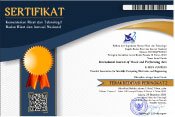(2) Wahyu Nova Riski
(3) Syamsul Barry
*corresponding author
AbstractThis study investigates narrative strategies in contemporary Indonesian horror films to understand how they convey cultural meanings and engage audiences. While horror is often dismissed as entertainment, Indonesian horror serves as a cultural mirror, reflecting societal fears, spiritual beliefs, and identity struggles. The study focuses on eight films released between 2019 and 2024, selected for their narrative complexity, cultural relevance, and critical reception. Using qualitative narrative analysis, the research applies Seymour Chatman's distinction between story and discourse alongside classical and modern narrative theories by Bordwell, Todorov, Genette, and others. The analysis identifies three-act and five-act structures and nonlinear, circular, and episodic narratives. These structures enhance suspense, emotional engagement, and thematic depth. The findings show that Indonesian horror films blend local folklore, Islamic rituals, and communal values with experimental storytelling. For example, Siksa Kubur uses fragmented timelines to depict trauma, while Qodrat integrates religious exorcism into its plot structure. Such strategies deepen audience immersion and articulate culturally specific anxieties. This research contributes to Indonesian cinema studies by highlighting how narrative form shapes meaning and emotional impact. It offers a framework for analyzing horror beyond Western paradigms and provides insights into how traditional and modern storytelling coexist in Southeast Asian media. Academically, it advances narrative theory in a non-Western context. Practically, it supports filmmakers and cultural producers in using horror to engage with social issues and connect with global audiences through culturally grounded storytelling.
KeywordsHorror; Indonesian films; Narrative strategies; Cultural heritage
|
DOIhttps://doi.org/10.31763/viperarts.v7i1.1790 |
Article metrics10.31763/viperarts.v7i1.1790 Abstract views : 229 | PDF views : 115 |
Cite |
Full Text Download Download
|
References
[1] D. Bordwell and K. Thompson, Film Art: An Introduction. 2001.
[2] T. Todorov, “The poetics of prose.(translated by Jonathan Culler-1977).†New York: Cornell University Press, 1971.
[3] G. Genette, Narrative discourse: An essay in method, vol. 3. Cornell University Press, 1980.
[4] M. Smith, Engaging Characters: Fiction, emotion, and the cinema. Oxford University PressOxford, 2022. doi: 10.1093/oso/9780198871071.001.0001
[5] C. Plantinga, Moving viewers: American film and the spectator’s experience. University of California Press, 2009. doi: 10.1525/9780520943919
[6] L. Mulvey, Visual and Other Pleasures. London: Palgrave Macmillan UK, 1989. doi: 10.1007/978-1-349-19798-9
[7] B. Hooks, Reel to real: race, class and sex at the movies. Routledge, 2009.
[8] R. Altman, Conclusion: a semantic/syntactic/pragmatic approach to genre. Bloomsbury Publishing (UK), 1999.
[9] L. Manovich, “The Language of New Media,†Can. J. Commun., vol. 27, no. 1, Jan. 2002, doi: 10.22230/cjc.2002v27n1a1280.
[10] H. Naficy, An Accented Cinema: Exilic and Diasporic Filmmaking. Princeton University Press, 2001. doi: 10.1515/9780691186214
[11] S. Chatman, “Story and discourse: Narrative structure,†Fict. Film, 1978.
[12] J. Anwar, Satan’s Slaves 2: Communion/Pengabdi Setan 2: Communion. Indonesia, 2022.
[13] I. A. C. GozaliImron, Qodrat. Indonesia, 2022.
[14] D. Tiwahyupriadi and Y. Ayuningtyas, “Indonesian Horror Film: Deconstruction of Repetitive Elements of Indonesian Urban Legend for Cultural Revitalization, Creativity, and Critical Thinking,†KnE Social Sciences. 02-Sep-2020, doi: 10.18502/kss.v4i12.7589.
[15] B. M. Fatha and A. Z. Mansoor, “The structural analysis of Indonesian horror webtoon’s visual and narrative,†in Contemporary trends in management and administration, South Florida Publishing, 2022, pp. 50–63. doi: 10.47172/sfp2020.ed.0000051
[16] E. Saberi, “The Impact of Non-linear Narrative Structures on Better Character Development in Animated-short Movies,†Avanca|Cinema, no. 14, Oct. 2023, doi: 10.37390/avancacinema.2023.a505.
[17] C. Zimmer, “Serial Surveillance: Narrative, Television, and the End of the World,†Film Q., vol. 72, no. 2, pp. 12–25, Dec. 2018, doi: 10.1525/fq.2018.72.2.12.
[18] T. Krysanova, “Psycholinguistic and cognitive-semiotic dimensions of constructing fear in horror films: A multimodal perspective,†East European Journal of Psycholinguistics. 29-Jun-2023, doi: 10.29038/eejpl.2023.10.1.kry.
[19] J. Anwar, Grave Torture/Siksa Kubur. Indonesia, 2024.
[20] S. Wahyuni, S. Darma, and S. Saaduddin, “Penciptaan film fiksi ‘dibalik sungai ular’ menggunakan alur non-linear,†Gorga J. Seni Rupa, vol. 10, no. 1, p. 45, Apr. 2021, doi: 10.24114/gr.v10i1.22018.
[21] B. A. Priyambodho and K. A. Suwito, “Deconstructive Reading of Indonesian Contemporary Horror Film Texts,†Talent Dev. Excell., vol. 12, no. 2, 2020.
[22] A. Liu, “Analysis on the Basic Narrative Structure of Short Films,†Arts Stud. Crit., vol. 2, no. 3, Sep. 2021, doi: 10.32629/asc.v2i3.451.
[23] E. Saberi, “Modern narrative structure in animated short films: a tool to increase suspense,†Avanca|Cinema, no. 14, Oct. 2023, doi: 10.37390/avancacinema.2023.a500.
[24] J. Zhu and Y. Wu, “Christopher Nolan s Cinematic Art: Exploring Non-linear Narratives and Thematic Depth,†Res. Comment. Humanit. Arts, vol. 2, no. 3, Jun. 2024, doi: 10.18686/rcha.v2i3.4100.
[25] R. Mantovani, The Train of Death/Kereta berdarah. Indonesia, 2024.
[26] S. Seyler, “What Are You So Scared About?: Understanding the False Fear Response to Horror Films,†Nc Docs. 2019.
[27] K. Stamboel, Dancing Village: The Curse Begins/Badarawuhi di desa Penari. Indonesia, 2024.
[28] A. Sutandio, “Skinned Performance: Female Body Horror in Joko Anwar’s Impetigore,†Rupkatha J. Interdiscip. Stud. Humanit., vol. 14, no. 1, Feb. 2022, doi: 10.21659/rupkatha.v14n1.14.
[29] J. Anwar, Impetigore/Perempuan tanah jahanam. Indonesia, 2019.
[30] H. D. Ratu, The Corpse Washer/Pemandi Jenazah. Indonesia, 2024.
[31] D. T. Nardy and J. Coates, “Back to the future: imaginaries of Africa on East Asian Screens,†Open Screens, vol. 4, no. 1, 2021.
[32] B. M. Fatha and A. Z. Mansoor, “The structural analysis of indonesian horror webtoon’s visual and narrative,†South Florida J. Dev., vol. 3, no. 1, pp. 1624–1636, Feb. 2022, doi: 10.46932/sfjdv3n1-126.
[33] E. Hidayat, D. Susilo, and M. Mujiono, “Are Audience Preferences for Electronic Cinema Affected by Preferences in Indonesian Movie Choices?,†Nyimak J. Commun., vol. 7, no. 2, p. 297, Sep. 2023, doi: 10.31000/nyimak.v7i2.9299.
Refbacks
- There are currently no refbacks.
Copyright (c) 2025 Zainal Abidin; Wahyu Nova Riski; Syamsul Barry

This work is licensed under a Creative Commons Attribution-ShareAlike 4.0 International License.
___________________________________________________________
International Journal of Visual and Performing Arts
ISSN 2684-9259
Published by Association for Scientific Computing Electronics and Engineering (ASCEE)
W: http://pubs2.ascee.org/index.php/viperarts
E: sularso@ascee.org
Organized by:
 This work is licensed under a Creative Commons Attribution-ShareAlike 4.0
This work is licensed under a Creative Commons Attribution-ShareAlike 4.0
























